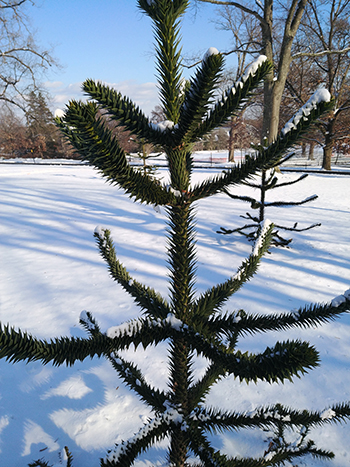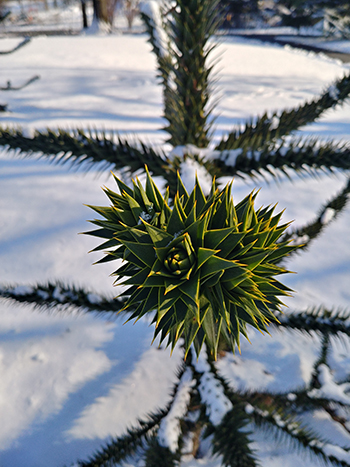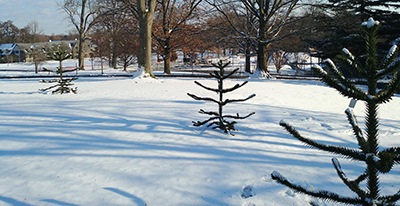
Plant of the Month: Araucaria araucana

Starting with the common name “monkey puzzle tree,” Araucaria araucana promises to excite and puzzle those unfamiliar with it. A. araucana is a member of the ancient Araucaria genus (of the Araucariaceae family), a group of trees of the Southern Hemisphere, whose lineage dates to the Jurassic period. A. araucana is the most cold hardy and the best known of the genus. A. araucana is endemic to foggy slopes of The Andes between Chile and Argentina, where it often grows at high elevations in well-draining soils derived from volcanic rocks.
Sharp, scale-like leaves bestow a reptilian appearance to this evergreen conifer. The thick trunk and branches are laden with these scales, which seem to shout “Don’t touch!”. At the branch tips a dense whorl of leaves surrounds the terminal bud, like a mini agave. The novel scale-like leaves persist for about 25 years before being shed.

Symmetrical branching with upturned tips creates a candelabra effect on young trees while an egg shape marks the later stages of youth. As plants mature the branches become pendulous, the tips still upturned. Eventually A. araucana develops a tall, slender umbrella form, the trademark look of the species. I love the various habits of this tree, each fun and appealing in its own way.
What’s with the common name?! It seems to be from a prominent British politician who, when showing a specimen to friends, remarked it would puzzle a monkey to climb it. Being very rare at the time, there was no common name, and so “monkey puzzle tree” stuck – or so the story goes.
A theoretical head- (and hand-) ache for a monkey indeed! The spikes are hypothesized to have been an adaptation against much bigger pests, though: dinosaurs! The species is also uniquely adapted to the threat of fire; the thick bark is highly fire resistant and epicormic shoots may be produced after fires.
As you can imagine, A. araucana makes a bold statement in the landscape. It can be used as a specimen, accent, or in a grouping. Trees grown in cultivation can expect to grow 20’-30’, and maintain a conical shape.
Naturally occurring trees can grow upwards of 130’ and live 1,000 years. The tall trunks of mature A. araucana have historically been prized for lumber, contributing to species endangerment; Luckily, they are now protected from harvest by law.
As mentioned before, A. araucana prefers a well-drained soil and a high moisture environment. In its native environment, this tree experiences wet summers and dry winters, a weather trait unique to few places. Because we have no dry season here, well-draining soil is especially crucial to the species’ success. Though A. araucana prefers full sun, it dislikes high and prolonged heat. These preferences make A. araucana a great choice for the Pacific Northwest, but the somewhat picky nature of this tree can make it tricky to please on our side of the country.
One of the few places I’ve seen A. araucana grown on the East Coast is Polly Hill Arboretum in Martha’s Vineyard, MA. Here, a group of trees have grown to impressive size, weathering decades of New England winters. This may seem like an unlikely place for this zone 7(8) species to thrive, but the milder temperatures of the island, sandy soil and moist air help orchestrate this botanical feat.

Inspired by the Polly Hill planting, the Scott Arboretum sought to introduce a group of A. araucana trees. Originally planted in the low-lying pinetum, the trees failed. Recognizing the need for better drainage, a second attempt was made to establish 5 trees at a higher location on Parrish Lawn, near Clothier Hall. Planted in 2019, 3 remain and are approximately 6’ now – fingers crossed!
Visit the Scott Arboretum today to see this one-of-a-kind tree for yourself! And consider exploring the newly renovated Pinetum, where you can find many more unique conifers, new paths, and a grand seating area.





Robert H Roggeveen
Posted at 10:22h, 27 JanuaryA remarkable tree to see in Chile. Good luck with your efforts. I enjoyed seeing the Araucaria araucana at Polly Hill.
One day I hope to see the ones you superintend! There are some movely specimens in the Strybing Arboretum at the San Francisco Botanical Garden – but then San Francisco is a bit more like their home.
Thank you